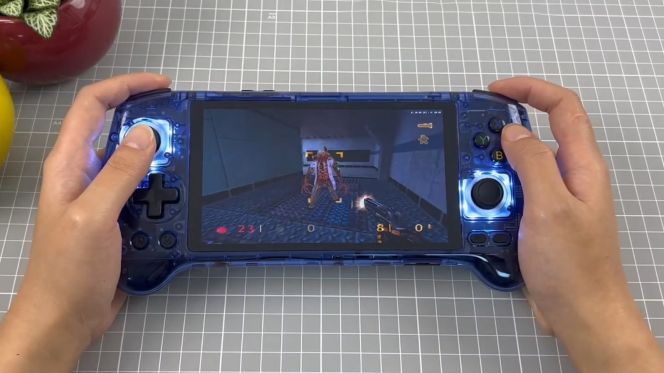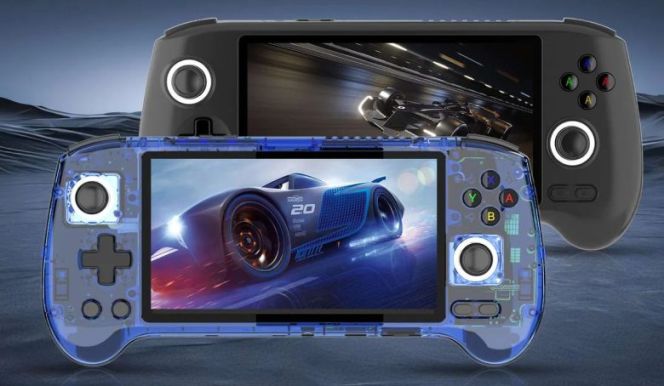TECH REVIEW – Anbernic’s latest entry, the RG556, is a 5.48-inch Android-based handheld designed for emulation, featuring an AMOLED display and powered by a Unisoc T820 processor. Positioned to compete directly with the Retroid Pocket 4 lineup, this device sits comfortably between the base model and the Pro version in both price and performance, making it an appealing alternative to what Retroid offers. But does it deliver the upgrade Anbernic fans have been hoping for? Special thanks to GeekBuying for providing a unit for us to test!
Anbernic makes a return with yet another retro gaming handheld: the RG556. This is the brand’s most powerful Android device so far, and it’s now available for pre-order. Let’s dive into the details and see what this device has in store!
The RG556 is equipped with a Unisoc T820 processor, a Mali-G57 GPU, 8GB of RAM, and 128GB of internal storage. It comes with built-in Wi-Fi and Bluetooth, plus a 5500 mAh battery that offers an average of about 8 hours of use. The screen is a 5.48-inch AMOLED display with a 16:9 aspect ratio and a resolution of 1920 x 1080, complete with touchscreen functionality for easier navigation.
Anbernic’s Most Ergonomic Retro Handheld Yet
In terms of design, the RG556 really stands out among Anbernic’s offerings. Previously, the company focused on compact, pocket-friendly devices with inline shoulder buttons and a symmetrical joystick layout. However, with the RG556, Anbernic has taken a different approach. The handheld is wider and thicker, featuring integrated grips, stacked shoulder buttons with analog triggers, and an asymmetrical joystick layout.
This design might not appeal to those who prefer pocket-sized handhelds, but what you get in return is a highly ergonomic and comfortable device. Weighing in at 331 grams, the RG556 is relatively lightweight, making it easy to carry around and use for extended periods. It fits snugly in your hands, with fingers naturally wrapping around the grips, while all the buttons are easily accessible. Only the power and volume buttons require a bit of a stretch, but this doesn’t detract from the overall user experience. In fact, this may be Anbernic’s most ergonomic landscape-oriented device to date.
Excellent Hardware, Minor Drawbacks
Complementing its ergonomic design, the RG556 boasts impressive hardware. As is typical for Anbernic, there’s little to criticize here. The D-pad is well-crafted for retro gaming, and the face buttons provide satisfying tactile feedback thanks to their membrane switches. The Hall effect-based analog triggers deliver a nice level of resistance, and the joysticks, also based on Hall effect technology, prevent the dreaded “stick drift.”
Despite the generally solid hardware, a few shortcomings are worth noting. The plastic casing is not the best Anbernic has produced; while it doesn’t feel particularly cheap, it does have a somewhat plasticky feel, especially around the hollow grips. The matte finish of the shell is prone to collecting fingerprints and dust, which can detract from its appearance. A quick wipe can help, but this is a recurring issue after every use, particularly during long gaming sessions.
Another hardware decision I’m not fond of is the placement of the speakers. Located at the bottom of the grips, they give the device a somewhat unconventional look. Personally, I would have preferred front-facing speakers to enhance the gaming experience and deliver richer sound quality.
Gaming Performance on the Anbernic RG556
Powered by a Unisoc T820 processor, the RG556, with its 8GB of RAM and 128GB of storage, falls into the mid-range category—backed by its Geekbench 6 scores. This configuration allows the Android 13-based device to handle Android games quite well. Fortunately, the Play Store comes pre-installed, making it easy to download your favorite games. Titles like Half-Life 2, Portal, and Alien: Isolation perform smoothly on their Android versions. The operating system also offers a convenient mapping feature, allowing you to assign touchscreen controls to the physical buttons, which is particularly useful for games like Genshin Impact and Ni no Kuni: Cross Worlds that don’t natively support controller input.
The Unisoc T820 processor also proves its worth in emulation. For less demanding systems, performance is solid. Dreamcast games like Crazy Taxi 2 and Dead or Alive 2 run at a steady 60 fps, while GameCube titles like Metal Gear Solid: The Twin Snakes and The Legend of Zelda: Twilight Princess play at 30 fps at 2x resolution. For the latter, it’s worth noting that switching to the OpenGL backend was necessary to correct some graphical glitches.
Performance Limits: PS2 and Switch Games
The RG556 handles PS2 games quite effectively. Titles like Ratchet & Clank run well at 2x resolution, maintaining a frame rate of 50-60 fps. However, other titles, such as God of War 2, suffer from stuttering, dropping to 15-25 fps. Lowering the resolution to 1x improves smoothness, though occasional hiccups still occur. Applying mild underclocking in the performance settings can help mitigate these issues. Most PS2 games are playable on the RG556, but achieving optimal performance requires some tweaking.
When it comes to more demanding systems like the Switch, performance tends to be game-dependent. On the Yuzu emulator at 1x resolution, Cuphead runs at around 50-60 fps, Untitled Goose Game runs at 25-30 fps, and Cult of the Lamb runs at 20-30 fps. There is some noticeable stuttering in each case, which future updates or adjustments may resolve. Still, it’s impressive to see this budget-friendly device handle certain Switch titles.
Beyond its quality hardware buttons, the RG556’s AMOLED screen significantly enhances the gaming experience, whether playing native Android games or emulating retro systems. The display’s sharp visuals elevate the overall experience. The built-in 5500 mAh battery also provides reasonable longevity, with around 5 hours of playtime on average, though this will vary depending on individual usage.
Anbernic’s Best Device Yet
The RG556 is, without a doubt, the best device Anbernic has produced to date. It combines ergonomic design, high-quality buttons, a crisp AMOLED display, and an attractive price-performance ratio.
That said, as with all Anbernic devices, there are some drawbacks. These devices often don’t deliver top-tier performance in their target segments, or they come at a relatively higher price point. However, the RG556 is different, as the Unisoc T820 processor is surprisingly capable, offering more than respectable emulation performance for the price.
The main weakness lies in the build quality of the shell (especially when compared to previous Anbernic models) and some reported issues with color tinting on the display, though I didn’t find this to be significant.
My primary criticism focuses on the software. Traditionally, Anbernic devices—especially those based on Linux—have suffered from non-intuitive user interfaces that often required community support to fix. Switching to Android addresses some of these issues by providing greater customization options. Anbernic has also integrated a stylish front-end, accessible via a dedicated button, but the implementation isn’t perfect. It’s not entirely intuitive, and it often requires a lot of fiddling to get things set up just right. I found the standard Android launcher more practical, although the dedicated buttons for the front end are a nice touch. Hopefully, Anbernic will continue refining this aspect in future models.
It’s also worth noting that the console doesn’t provide optimal performance across all systems out of the box. More demanding systems require some fine-tuning, and it would be more convenient if these settings were optimized by default.
Final Thoughts: Is It Worth Buying?
Overall, the Anbernic RG556 offers fantastic value for money and is worth considering if you’re looking to upgrade your retro handheld—especially if you’re interested in an Anbernic model. It’s comfortable to use, has a high-quality display, and performs well, even emulating some Switch games. I hope Anbernic makes further improvements to the software, and if they plan a hardware update, I would love to see a version with their signature metal casing.
-Gergely Herpai “BadSector”-
If you decide to invest in an Anbernic RG556 based on our test, you can buy it here on GeekBuying.
256GB TF card, 8714 games: €205 after coupon code 【NNN556GC】
128GB TF card, 4423 game: €195 after coupon code 【NNNRG556A】
Pros:
+ Attractive price-value ratio
+ Ergonomic design
+ Sharp AMOLED display
Cons:
– Plastic casing prone to fingerprints
– Difficult to use user interface
– For optimal performance of the emulator, the settings must be changed for more demanding systems
ANBERNIC RG556
Design - 7.2
Display - 9.1
Software/Emulation - 6.8
Battery Life - 8.1
Price/Quality - 8.4
7.9
GOOD
The RG556 represents Anbernic's most refined device to date and offers one of the best price-to-performance ratios in the current generation of retro handheld consoles.


















Leave a Reply